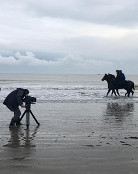Donn's Articles » Ballydoyle jockey quandary
Ballydoyle jockey quandary
“Choose wisely, for while the true Grail will bring you life, the false Grail will take it from you.”
If life choices were measured on the Beaufort Scale, the choice of which horse to ride in a horse race would probably lie somewhere between a light air and a gentle breeze. When you are Ballydoyle’s number one rider, however, it is up there in strong gale territory.
To feel sorry for Johnny Murtagh is to feel sorry for Pep Guardiola (Messi or Xavi?), but to have the pick of one of the best teams of thoroughbreds that is assembled anywhere in the world brings with it its own difficulties.
We are talking Derby here, Epsom Derby, the Champions League Final for thoroughbreds. The Coolmore/Ballydoyle heart has always beat to the rhythm of the Epsom Derby. When Vincent O’Brien and Robert Sangster and John Magnier went scouring the fields of Kentucky and the enclosures of Keeneland’s July Sale in the 1970s and 1980s looking for embryo stallions, it was the Epsom Derby more than any other race that influenced their thinking. Little in terms of ethos has changed in that regard in almost 40 years. The Derby is still racing’s Holy Grail.
The esteem in which the race is held at Ballydoyle is evident in the no-holds-barred approach that Aidan O’Brien takes to it every year. If a Ballydoyle colt has proven that he is deserving of a place in the Derby line-up, however small his chance of winning it seems to be, he lines up in the race, that appears to be the rule. In the eight renewals of the Derby since Galileo won it as O’Brien’s sole representative in 2001, no fewer than 35 colts have carried the Ballydoyle flag over Epsom’s contours.
Remarkably, in each of the last seven years when Ballydoyle have had a multiple entry in the Derby, only once has the stable jockey chosen the best-placed finisher. Last year, Johnny Murtagh chose to ride Rip Van Winkle, who finished fourth overall and only third of the Ballydoyle runners. In 2007, Murtagh chose King Of Rome, who finished fourth of the five Ballydoyle horses, while in 2006, Kieren Fallon rode Horatio Nelson, who was regrettably fatally injured in the race. In 2005, Fallon chose correctly when he chose Gypsy King, best of the Ballydoyle runners but no better than fifth overall, while in 2003 Michael Kinane rode Brian Boru, who finished fourth of the four Aidan O’Brien-trained horses.
Even in 2002, when two of the three Ballydoyle representatives finished first and second in the race, it was the horse that Kinane passed over, High Chaparral, who won it, beating him and Hawk Wing into second place, with Johnny Murtagh, in an ironic pointer to the future, coming in for the ride on the winner.
While the stable jockey’s quandary is not confined to the Derby (ref. Rock Of Gibraltar’s 2000 Guineas – J P Murtagh again), it is understandable that it is more acute in the Blue Riband than in any other race. As well as the multiple declarations, and the difficulty that is inherent in choosing between several horses, multiple choice rather than dichotomous, there is also the fact that there are innumerable immeasurable variables concerning the Derby. It comes up early in the season, when three-year-old colts are still improving, almost certainly at different rates. You are all the while guessing at the degree to which these adolescents have progressed from their previous runs.
On top of that, the test that the Derby presents to a thoroughbred is inimitable, one that is impossible to simulate even if you wanted to. The racecourse is unique, one man’s unfair track, another’s true test, with its right turns and its left turns, its sweeping downhill run into the straight and its cambers away from the rail and towards it. Also, the occasion is unique, with its animated babbling throng that encroaches on you from every angle and stress-tests each horse’s mentality. And then there is the distance. Most horses who run in the Derby have never been tried over a mile and a half before, so you consider their breeding and their running style and engage in some more guesswork. If you know that they stay the trip, they probably aren’t fast enough to win a Derby.
Of course Murtagh is in an enviable position, most jockeys would give their eye teeth to have the pick of the Ballydoyle Derby battalions, and the charge this year is shaping up to be the strongest at least since 2002. The fact that Murtagh has taken over from Sam Curling as St Nicholas Abbey’s work rider suggests that the current favourite is probably the one. The rider has never tried to hide the regard in which he holds the son of Montjeu. He is this year’s Rip Van Winkle.
However, Murtagh still has a choice to make, and Jan Vermeer’s win in the Gallinule Stakes at The Curragh on Sunday didn’t make things any easier. He won’t make it lightly, he won’t make it without exploring every avenue, considering every aspect. You only get one chance every year to win the Champions League. Guardiola can choose 11, Murtagh has to choose just one.
© The Racing Post, 25th May 2010


 Follow Donn
Follow Donn